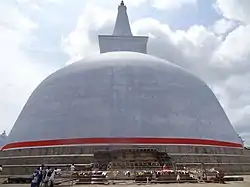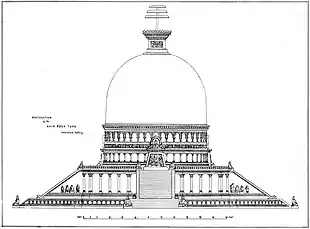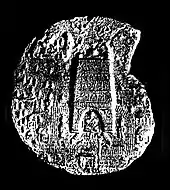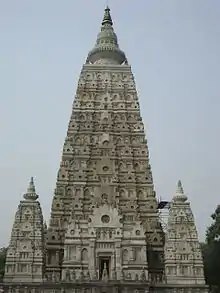| Translations of Stupa | |
|---|---|
| English | Stupa |
| Sanskrit | स्तूप |
| Pali | 𑀣𑀼𑀩𑁂 ("thube"), thūpa |
| Bengali | স্তূপ (st̪up) |
| Burmese | စေတီ (MLCTS: zèdì) |
| Chinese | 窣堵坡 (Pinyin: sūdǔpō) |
| Japanese | 卒塔婆 (Rōmaji: sotoba) |
| Khmer | ចេតិយ, ស្តូប (UNGEGN: chétĕy, stob) |
| Korean | 솔도파 (RR: soldopha) |
| Mongolian | суварга (suvarga) |
| Sinhala | දාගැබ් (dagab) |
| Tibetan | མཆོད་རྟེན་ (mchod rten (chorten)) |
| Tamil | தாது கோபுரம் |
| Thai | สถูป, เจดีย์ (RTGS: sa thup, chedi) |
| Vietnamese | Phù đồ, bảo tháp |
| Glossary of Buddhism | |
In Buddhism, a stupa (Sanskrit: स्तूप, lit. 'heap', IAST: stūpa) is a mound-like or hemispherical structure containing relics (such as śarīra – typically the remains of Buddhist monks or nuns) that is used as a place of meditation.[1]
Circumambulation or pradakhshina has been an important ritual and devotional practice in Buddhism since the earliest times, and stupas always have a pradakhshina path around them. The original South Asian form is a large solid dome above a tholobate or drum with vertical sides, which usually sits on a square base. There is no access to the inside of the structure. In large stupas there may be walkways for circumambulation on top of the base as well as on the ground below it. Large stupas have or had vedikā railings outside the path around the base, often highly decorated with sculpture, especially at the torana gateways, of which there are usually four. At the top of the dome is a thin vertical element, with one of more horizontal discs spreading from it. These were chatras, symbolic umbrellas, and tend not to have survived, if not restored. The Great Stupa at Sanchi, Madhya Pradesh, is the most famous and best-preserved early stupa in India.
Apart from very large stupas, designed to attract pilgrims, there were large numbers of smaller stupas in a whole range of sizes, which typically had much taller drums, relative to the height of the dome. Small votive stupas paid for by pilgrims might be less than a metre high, and laid out in rows by the hundred, as at Ratnagiri, Odisha.
As Buddhism spread, other forms were used for the same purposes, and the chortens of Tibetan Buddhism, and the pagodas of East Asian Buddhism are some of these. In South-East Asia various rather different elongated shapes of dome evolved, leading to high, thin spires. A related architectural term is a chaitya, which is a prayer hall or temple containing a stupa.
Description and history

Stupas may have originated as pre-Buddhist tumuli in which śramaṇas were buried in a seated position[2] called caitya.[3]
In early Buddhist inscriptions in India stupa and caitya appear to be almost interchangeable, though caitya has a broader meaning, and unlike stupa does not define an architectural form. In pre-Buddhist India caitya was a term for a shrine, sanctuary or holy place in the landscape, generally outdoors, inhabited by, or sacred to, a particular deity. In the Mahāyāna Mahāparinirvāṇa Sūtra, near the end of his life the Buddha remarks to Ananda how beautiful are the various caitya round Vaishali.[4] In later times and in other countries Cetiya/caitya implies the presence of important relics. Both words have forms prefixed by maha for "great", "large" or "important", but scholars find the difference between a mahastupa and a stupa, or mahacetiya and cetiya hard to pin down.[5]
Some authors have suggested that stupas were derived from a wider cultural tradition from the Mediterranean to the Ganges Valley,[6] and can be related to the conical mounds on circular bases from the 8th century BCE that can be found in Phrygia (tomb of Midas, 8th c. BCE), Lydia (such as the tomb of Alyattes, 6th c. BCE), or in Phoenicia (tombs of Amrit, 5th c. BCE).[7][8] Some authors suggest stupas emerged from Megalithic mound burials with chambers which likely represents proto-stupa.[9][10][11]
Archaeologists in India have observed that a number of early Buddhist stupas or burials are found in the vicinity of much older, pre-historic burials, including megalithic burial sites.[10] This includes site associated with the Indus Valley civilization where broken Indus-era pottery was incorporated into later Buddhist burials.[10] Scholars have noted structural and functional features of the stupa (including its general mound shape and the practice of surrounding stupas with a stone, relic chamber or wooden railing) with both pre-Mauryan era cairn and pre-historic megalithic "round mound" burials with chambers found India, which likely represents a “proto-stupa”.[12][10] In Dholavira, an archeological site associated with Indus Valley Civilization, there are several large and high "hemispherical monuments" of tumulus with brick-masonry found with burial chambers inside. Among them, Tumulus-1 and Tumulus-2 mounds were excavated. They consist of a deep and wide rock-cut chamber, surrounded on the ground by a massive circular mud-brick structure made in two-tiers, and filled in and topped with random earth to form a domical shape.[13] There is also evidence of plastering on the exterior of Tumulus-1 mound, bearing a 10- mm thick plaster of pinkish-white clay over brick masonry.[13] These forms of hemispherical monuments or tumulus of brick-masonry with similar layouts may have been likely inspiration for later stupas.[11] Some stupas not believed to have been looted have been found to be empty when excavated, as have some pre-historic cairn sites, and animal bones are suspected to have occasionally been deposited at both types of sites.[10]
Mounds for the relics of the Buddha (5th century BCE)
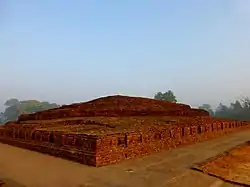
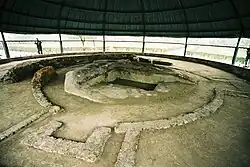
Religious buildings in the form of the Buddhist stupa, a dome shaped monument, started to be used in India as commemorative monuments associated with storing sacred relics of the Buddha.[14] After the parinirvana of the Buddha, his remains were cremated and the ashes divided and buried under eight mounds with two further mounds encasing the urn and the embers.[14]
According to some early Buddhist sources, the Buddha himself had suggested this treatment, and when asked what a stupa was, had demonstrated the basic design: he folded his robe on the ground, placed his begging-bowl upside down on it, with his staff above that.[15]
The relics of the Buddha were spread between eight stupas, in Rajagriha, Vaishali, Kapilavastu, Allakappa, Ramagrama, Pava, Kushinagar, and Vethapida.[16] The Piprahwa stupa also seems to have been one of the first to be built.[16] Lars Fogelin stated that the Vaisali relic stupa and Nigali Sagar stupa are likely the earliest archaeologically known stupas.[17][18]
Guard rails —consisting of posts, crossbars, and a coping— became a feature of safety surrounding a stupa.[19] The Buddha had left instructions about how to pay homage to the stupas: "And whoever lays wreaths or puts sweet perfumes and colours there with a devout heart, will reap benefits for a long time".[20] This practice would lead to the decoration of the stupas with stone sculptures of flower garlands in the Classical period.[20]
Expansion under Ashoka (250 BCE)
According to Buddhist tradition, Emperor Ashoka (rule: 273—232 BCE) recovered the relics of the Buddha from the earlier stupas (except from the Ramagrama stupa), and erected 84,000 stupas to distribute the relics across India. In effect, many stupas are thought to date originally from the time of Ashoka, such as Sanchi or Kesariya, where he also erected pillars with his inscriptions, and possibly Bharhut, Amaravati or Dharmarajika in Gandhara.[16] Ashoka also established the Pillars of Ashoka throughout his realm, generally next to Buddhist stupas.
The first known appearance of the word "Stupa" is from an inscribed dedication by Ashoka on the Nigali Sagar pillar (spelled in Pali in the Brahmi script as 𑀣𑀼𑀩𑁂 "Thube" ).[22]
Decorated stupas (from 125 BCE)
Stupas were soon to be richly decorated with sculptural reliefs, following the first attempts at Sanchi Stupa No.2 (125 BCE). Full-fledged sculptural decorations and scenes of the life of the Buddha would soon follow at Bharhut (115 BCE), Bodh Gaya (60 BCE), Mathura (125-60 BCE), again at Sanchi for the elevation of the toranas (1st century BCE/CE) and then Amaravati (1st-2nd century CE).[23] The decorative embellishment of stupas also had a considerable development in the northwest in the area of Gandhara, with decorated stupas such as the Butkara Stupa ("monumentalized" with Hellenistic decorative elements from the 2nd century BCE)[24] or the Loriyan Tangai stupas (2nd century CE).
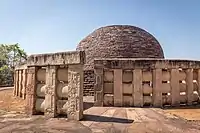 Sanchi Stupa No.2, the earliest known stupa with important displays of decorative reliefs, circa 125 BCE[25]
Sanchi Stupa No.2, the earliest known stupa with important displays of decorative reliefs, circa 125 BCE[25]
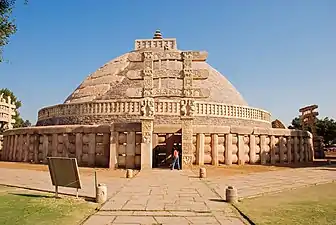
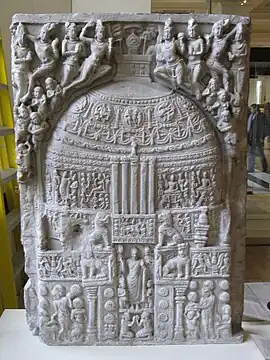 Amaravati stupa, 1st-2nd century CE
Amaravati stupa, 1st-2nd century CE
Development in Gandhara (3rd century BCE-5th century CE)

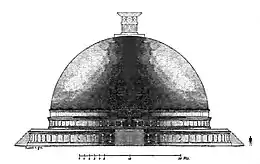
The stupa underwent major evolutions in the area of Gandhara. Since Buddhism spread to Central Asia, China and ultimately Korea and Japan through Gandhara, the stylistic evolution of the Gandharan stupa was very influential in the later development of the stupa (and related artistic or architectural forms) in these areas.[27] The Gandhara stupa followed several steps, generally moving towards more and more elevation and addition of decorative element, leading eventually to the development of the pagoda tower.[28] The main stupa type are, in chronological order:
- The Dharmarajika Stupa with a near-Indian design of a semi-hemispheric stupa almost directly on the ground surface, probably dated to the 3rd century BCE. Similar stupas are the Butkara stupa, the Manikyala stupa or the Chakpat stupa.[21]
- The Saidu Sharif Stupa, pillared and quincunxial, with a flight of stairs to a dome elevated on a square platform. Many Gandhara minutiures represent this spectacular type (1st century CE).[29]
- The Loriyan Tangai Stupa, with an elongated shape and many narrative reliefs, in many way the Classical Gandharan stupa (2nd century CE).[30]
- The near-pyramidal Jaulian stupa (2nd century CE).[31]
- The cruciform type, as in the Bhamala Stupa, with flights of stairs in the four cardinal directions (4th century CE).[32]
- The towering design of the second Kanishka stupa (4-5th century CE).[33]
 A model resembling the Saidu Sharif Stupa, with square base and four columns (1st century CE).[34]
A model resembling the Saidu Sharif Stupa, with square base and four columns (1st century CE).[34]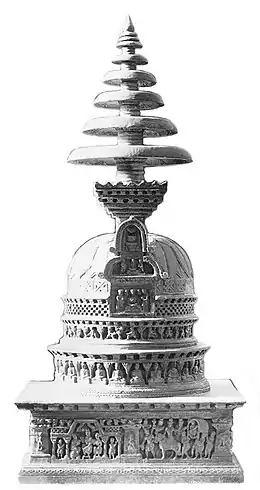
 A tower-shaped stupa, thought to be the design of the second (rebuilt) Kanishka stupa, Jaulian monastery[33]
A tower-shaped stupa, thought to be the design of the second (rebuilt) Kanishka stupa, Jaulian monastery[33] Stupa-shaped reliquary, Kushan period, about 2nd century CE
Stupa-shaped reliquary, Kushan period, about 2nd century CE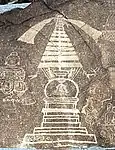
Origin of the pyramidal temple
It is thought that the temple in the shape of a truncated pyramid may have derived from the design of the stepped stupas which developed in Gandhara. The Mahabodhi Temple in Bodh Gaya is one such example, formed of a succession of steps with niches containing Buddha images, alternating with Greco-Roman pillars.[36] The structure is crowned by the shape of a hemispherical stupa topped by finials, forming a logical elongation of the stepped Gandharan stupas such as those seen in Jaulian.[36]
Although the current structure of the Mahabdhodi Temple dates to the Gupta period (5th century CE), the "Plaque of Mahabhodi Temple", discovered in Kumrahar and dated to 150-200 CE based on its dated Kharoshthi inscriptions and combined finds of Huvishka coins, suggests that the pyramidal structure already existed in the 2nd century CE.[36] This is confirmed by archaeological excavations in Bodh Gaya.[36]
This truncated pyramid design also marked the evolution from the aniconic stupa dedicated to the cult of relics, to the iconic temple with multiple images of the Buddha and Bodhisattvas.[36] This design was very influential in the development of later Hindu temples.[37]
Expansion in Asia
Asian stupas
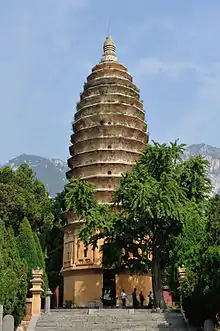

Stupa architecture was adopted in Southeast and East Asia, where it became prominent as a Buddhist monument used for enshrining sacred relics.[14] The Indian gateway arches, the torana, reached East Asia with the spread of Buddhism.[39] Some scholars hold that torii derives from the torana gates at the Buddhist historic site of Sanchi (3rd century BCE – 11th century CE).[40] In Tibet, the stupa became the chorten,[41] and the pagoda in East Asia.[42] The pagoda has varied forms that also include bell-shaped and pyramidal styles. In the Western context, there is no clear distinction between a stupa and a pagoda. In general, however, "stupa" is the term used for a Buddhist structure in India or Southeast Asia while "pagoda" refers to a building in East Asia which can be entered and which may be used for secular purposes. However, use of the term varies by region. For example, stupas in Burma tend to be referred to as "pagodas."
Stupas were built in Sri Lanka soon after Devanampiya Tissa of Anuradhapura converted to Buddhism. The first stupa to be built was the Thuparamaya. Later, many more were built over the years, some like the Jetavanaramaya in Anuradhapura, being one of the tallest ancient structures in the world.
Development of the pagoda
The Asian words for pagoda (tā in Chinese, t'ap in Korean, tháp in Vietnamese, tō in Japanese) are all thought to derive from the Pali word for stupa, thupa, the Sanskrit pronunciation being stupa.[43] In particular the type of the tower-like stupa, the last stage of Gandharan stupa development, visible in the second Kanishka stupa (4th century), is thought to be the precussor of the tower stupas in Turkestan and the Chinese pagodas such as Songyue Pagoda (523 CE).[38]
Notable stupas
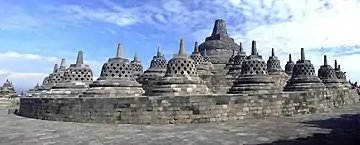
The earliest archaeological evidence for the presence of Buddhist stupas dates to the late 4th century BCE. Some of the oldest known examples of stupas are found in Vaishali, Kushinagar, Piprahwa, Ramgram, Sanchi, Sarnath, Amaravati and Bharhut.
With the top of its spire reaching 120.45 meters in height, Phra Pathommachedi in Nakhon Pathom, Thailand is the tallest extant stupa in the world.[44] The Swat Valley hosts a well-preserved stupa at Shingardar near Ghalegay; another stupa is located near Barikot and Dharmarajika-Taxila in Pakistan. In Sri Lanka, the ancient city of Anuradhapura includes some of the tallest, most ancient and best preserved stupas in the world, such as Ruwanwelisaya.
The most elaborate stupa is the 8th century Borobudur monument in Java, Indonesia. The upper rounded terrace with rows of bell-shaped stupas contained Buddha images symbolizing Arūpajhāna, the sphere of formlessness. The main stupa itself is empty, symbolizing complete perfection of enlightenment. The main stupa is the crown part of the monument, while the base is a pyramidal structure elaborated with galleries adorned with bas relief scenes derived from Buddhist texts and depicting the life of Gautama Buddha. Borobudur's unique and significant architecture has been acknowledged by UNESCO as the largest Buddhist monument in the world. It is also the world's largest Buddhist temple.[45][46] as well as one of the greatest Buddhist monuments in the world.[47]

A Jain stupa was excavated at Mathura in the 19th century.[48]
The Shwedagon Pagoda in Yangon, Myanmar is one of the largest and most holy stupas in the world.
European stupas
The Benalmádena Stupa is the tallest stupa in Europe. It is 33 m (108 ft) high and was inaugurated on 5 October 2003, the final project of Buddhist master Lopon Tsechu Rinpoche. Rinpoche built his first stupa at Karma Guen near Málaga in 1994,[49] a symbol of peace and prosperity for Spain.[50] Rinpoche went on to build 16 more stupas in Europe before his death in 2003.
A stupa was built on the ground of the Kalachakra Kalapa Centre in southwest Styria, Austria, between 2000 and 2002.
A stupa based on the bell shaped stupas at Borobodur, Central Java, is located at Amaravati Buddhist Monastery near Hemel Hempstead in the United Kingdom.[51]
Types of stupas
Built for a variety of reasons, Buddhist stupas are classified based on form and function into five types:[52]
- Relic stupa, in which the relics or remains of the Buddha, his disciples, and lay saints are interred.
- Object stupa, in which the items interred are objects belonged to the Buddha or his disciples, such as a begging bowl or robe, or important Buddhist scriptures.
- Commemorative stupa, built to commemorate events in the lives of Buddha or his disciples.
- Symbolic stupa, to symbolise aspects of Buddhist theology; for example, Borobudur is considered to be the symbol of "the Three Worlds (dhatu) and the spiritual stages (bhumi) in a Mahayana bodhisattva's character."[52]
- Votive stupa, constructed to commemorate visits or to gain spiritual benefits, usually at the site of prominent stupas which are regularly visited.
Symbolism
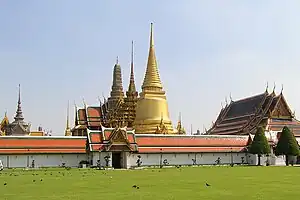
"The shape of the stupa represents the Buddha, crowned and sitting in meditation posture on a lion throne. His crown is the top of the spire; his head is the square at the spire's base; his body is the vase shape; his legs are the four steps of the lower terrace; and the base is his throne."[53]
Five purified elements
Although not described in any Tibetan text on stupa symbolism, the stupa may represent the five purified elements:[54]
- The square base represents earth
- The hemispherical dome/vase represents water
- The conical spire represents fire
- The upper lotus parasol and the crescent moon represent air
- The sun and the dissolving point represent wisdom
Construction
To build a stupa, Dharma transmission and ceremonies known to a Buddhist teacher are necessary.[55] The type of stupa to be constructed in a certain area is decided together with the teacher assisting in the construction. Sometimes the type is chosen directly connected with events that have taken place in the area.[55]

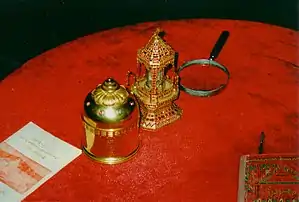
Treasury
All stupas contain a treasury filled with various objects. Small clay votive offerings called tsatsas in Tibetan fill most of the treasury. Creation of various types of tsatsas is a ceremony itself. Mantras written on paper are rolled into thin rolls and put into small clay stupas.[55] One layer of tsatsas is placed in the treasury, and the empty space between them is filled with dry sand. On the thus created new surface, another layer of tsatsas is made, and so on until the entire space of the treasury is full.[55]
The number of tsatsas required to completely fill the treasury depends on its size and the size of the tsatsa. For example, the Kalachakra stupa in southern Spain contains approximately 14,000 tsatsas.[55]
Jewellery and other "precious" objects are also placed in the treasury. It is not necessary that they be expensive, since it is the symbolic value that is important, not the market price.[55] It is believed that the more objects placed into the stupa, the stronger the energy of the stupa.[55]
Tree of Life
An important element in every stupa is the "Tree of Life". This is a wooden pole covered with gems and thousands of mantras; it is placed in the central channel of the stupa.[55] It is positioned during a ceremony or initiation, where the participants hold colorful ribbons connected to the Tree of Life. Together, the participants make their most positive and powerful wishes, which are stored in the Tree of Life. In this way the stupa is charged, and starts to function.[55]
Benefits
Building a stupa is considered extremely beneficial, leaving very positive karmic imprints in the mind. Future benefits from this action result in fortunate rebirths. Fortunate worldly benefits will be the result, such as being born into a rich family, having a beautiful body, a nice voice, being attractive, bringing joy to others, and having a long and happy life in which one's wishes are quickly fulfilled.[56] On the absolute level, one will also be able quickly to reach enlightenment, the goal of Buddhism.[56]
Destroying a stupa, on the other hand, is considered an extremely negative deed, similar to killing.[57] Such an action is said to create massive negative karmic imprints, leading to serious future problems. It is said this action leaves the mind in a state of paranoia after death has occurred, leading to totally unfortunate rebirths.[57]
Tibetan stupas
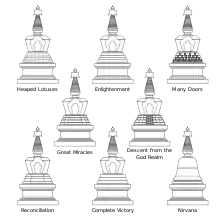

Stupas in Tibet and the Tibetan influenced regions of the Himalayas such as Bhutan are usually called chorten in English, reflecting the term in the Tibetan language. There are eight different shapes of chortens in Tibetan Buddhism, each referring to a major event in the Buddha's life.[54] The chortens are often made as a set, placed in a row. The Tibetan set differs slightly (by two events) from the Indian set of Eight Great Events in the Life of Buddha.
Lotus Blossom Stupa
Also known as "Stupa of Heaped Lotuses" or "Birth of the Sugata Stupa", this stupa refers to the birth of Gautama Buddha. "At birth Buddha took seven steps in each of the four directions"[54] (east, south, west and north). In each direction lotuses sprang up, symbolizing the brahmavihāras: love, compassion, joy and equanimity. The base of this stupa is circular and has four steps, and it is decorated with lotus-petal designs. Occasionally, seven heaped lotus steps are constructed. These refer to the seven first steps of the Buddha.[54]
Enlightenment Stupa

Also known as the "Stupa of the Conquest of Mara", this stupa symbolizes the 35-year-old Buddha's attainment of enlightenment under the bodhi tree in Bodh Gaya, where he conquered worldly temptations and attacks, manifesting in the form of Mara.[54]
Stupa of Many Doors
This stupa is also known as the "Stupa of Many Gates". After reaching enlightenment, the Buddha taught his first students in a deer park near Sarnath. The series of doors on each side of the steps represents the first teachings: the Four Noble Truths, the Six Pāramitās, the Noble Eightfold Path and the Twelve Nidānas.[54]
Stupa of Descent from the God Realm
At 42 years of age, Buddha spent a summer retreat in the Tuṣita Heaven where his mother had taken rebirth. In order to repay her kindness he taught the dharma to her rebirth. Local inhabitants built a stupa in Sankassa in order to commemorate this event. This type of stupa is characterized by having a central projection at each side containing a triple ladder or steps.[54]
Stupa of Great Miracles
Also known as the "Stupa of Conquest of the Tirthikas", this stupa refers to various miracles performed by the Buddha when he was 50 years old. Legend claims that he overpowered maras and heretics by engaging them in intellectual arguments and also by performing miracles. This stupa was raised by the Lichavi kingdom to commemorate the event.[54]
Stupa of Reconciliation
This stupa commemorates the Buddha's resolution of a dispute among the sangha. A stupa in this design was built in the kingdom of Magadha, where the reconciliation occurred. It has four octagonal steps with equal sides.[54]
Stupa of Complete Victory
This stupa commemorates Buddha's successful prolonging of his life by three months. It has only three steps, which are circular and unadorned.[54]
| Part of a series on |
| Buddhism |
|---|
.svg.png.webp) |
Stupa of Nirvana
This stupa refers to the parinirvana or death of the Buddha when he was 80 years old. It symbolizes his complete absorption into the highest state of mind. It is bell-shaped and usually unornamented.[54]
Kalachakra stupa
A ninth kind of stupa exists, the Kalachakra stupa. Its symbolism is not connected to events in the Buddha's life, but instead to the symbolism of the Kalachakra Tantra, created to protect against negative energies.[58]
Gallery
 An early stupa at Guntupalle, probably Maurya Empire, third century BCE
An early stupa at Guntupalle, probably Maurya Empire, third century BCE Buddha statue inside a votive stupa, Sarnath
Buddha statue inside a votive stupa, Sarnath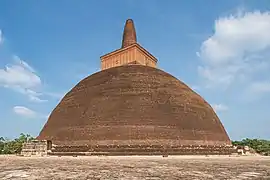 Abayagiri Dageba, Sri Lanka
Abayagiri Dageba, Sri Lanka Chorten near Potala Palace, Lhasa, Tibet
Chorten near Potala Palace, Lhasa, Tibet The white stupa in Miaoying Temple, China
The white stupa in Miaoying Temple, China The Kalachakra stupa in Karma Guen, Spain
The Kalachakra stupa in Karma Guen, Spain
Cambodia
.jpg.webp) Stupa of Kantha Bopha
Stupa of Kantha Bopha.jpg.webp) Stupa of King Norodom Suramarit
Stupa of King Norodom Suramarit Main stupa at Wat Phnom
Main stupa at Wat Phnom.jpg.webp) Stupa at Wat Botum
Stupa at Wat Botum Stupa at Oudong
Stupa at Oudong Golden stupa at Wat Ounalom
Golden stupa at Wat Ounalom
Kathmandu, Nepal
 Roadside stupa. Kathmandu 1979
Roadside stupa. Kathmandu 1979
 Boudhanath Stupa
Boudhanath Stupa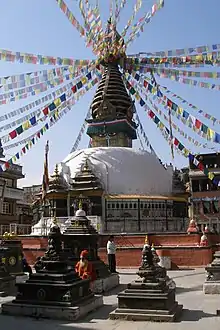
.jpg.webp) Stupa
Stupa Mahabaudha
Mahabaudha_on_Tahiti_Tole_square_(17823682692).jpg.webp) Tahiti stupa
Tahiti stupa Yetkha Stupa
Yetkha Stupa Small stupa in Kathmandu street
Small stupa in Kathmandu street
See also
References
- ↑ encyclopedia.com. Credited to James Stevens Curl, A Dictionary of Architecture and Landscape Architecture, 2000, originally published by Oxford University Press 2000.
- ↑ "Buddhist Art and Architecture: Symbolism of the Stupa / Chorten". 2006-08-14. Retrieved 2013-01-07.
- ↑ "THE BUDDHIST STUPA: ORIGIN AND DEVELOPMENT". 2005-01-13. Retrieved 2013-01-07.
- ↑ Skilling, 25
- ↑ Skilling, 23-24
- ↑ "It is probably traceable to a common cultural inheritance, stretching from the Mediterranean to the Ganges valley, and manifested by the sepulchres, conical mounds of earth on a circular foundation, of about the eighth century B.C. found in Eritrea and Lydia." Rao, P. R. Ramachandra (2002). Amaravati. Youth Advancement, Tourism & Cultural Department Government of Andhra Pradesh. p. 33.
- ↑ On the hemispherical Phenician tombs of Amrit: Coomaraswamy, Ananda K. (1972). History of Indian and Indonesian art. p. 12.
- ↑ Commenting on Gisbert Combaz: "In his study L'évolution du stupa en Asie, he even observed that "long before India, the classical Orient was inspired by the shape of the tumulus for constructing its tombs: Phrygia, Lydia, Phenicia ." in Bénisti, Mireille; K, Thanikaimony (2003). Stylistics of Buddhist art in India. Indira Gandhi National Centre for the Arts. p. 12. ISBN 9788173052415.
- ↑ M. Menon, Srikumar (16 September 2016). "The "Round Mound" and its Structural Requirements: A Possible Scenario for the Evolution of the Form of the Stupa" (PDF). National Institute of Advanced Studies. Retrieved 16 September 2016.
- 1 2 3 4 5 Schopen, Gregory. 2004. Buddhist Monks & Business Matters, pg. 361-74
- 1 2 Singh Bisht, Ravindra. "How the Harappans Honoured Death at Dholavira - Chapter VI. Hemispherical monument or tumulus". Archaeological Survey of India: 252–305. Retrieved 21 March 2011.
- ↑ M. Menon, Srikumar (16 September 2016). "The "Round Mound" and its Structural Requirements: A Possible Scenario for the Evolution of the Form of the Stupa" (PDF). National Institute of Advanced Studies. Retrieved 16 September 2016.
- 1 2 Singh Bisht, Ravindra. "How the Harappans Honoured Death at Dholavira - Chapter VI. Hemispherical monument or tumulus". Archaeological Survey of India: 271–284. Retrieved 21 March 2011.
- 1 2 3 Encyclopædia Britannica (2008), Pagoda.
- ↑ Soekmono, Dr, Chandi Borobudur: A Monument of Mankind, p. 39, 1976, Paris: Unesco Press. ISBN 92-3-101292-4, Full PDF
- 1 2 3 Buddhist Architecture, Lee Huu Phuoc, Grafikol 2009, p.140-174
- ↑ Fogelin, Lars (2015). An Archaeological History of Indian Buddhism. Oxford University Press. p. 85. ISBN 9780199948239.
- ↑ Lahiri, Nayanjot (2015). Ashoka in Ancient India. Harvard University Press. pp. 246–247. ISBN 9780674057777.
- ↑ Chandra (2008)
- 1 2 Buddhist Architecture, Lee Huu Phuoc, Grafikol 2009, p.143
- 1 2 Buddhist architecture, p.173
- ↑ Amaravati: The Art of an early Buddhist Monument in context. p.23
- 1 2 3 Buddhist Architecture, Lee Huu Phuoc, Grafikol 2009, p.149-150
- ↑ "De l'Indus a l'Oxus: archaeologie de l'Asie Centrale", Pierfrancesco Callieri, p212: "The diffusion, from the second century BCE, of Hellenistic influences in the architecture of Swat is also attested by the archaeological searches at the sanctuary of Butkara I, which saw its stupa "monumentalized" at that exact time by basal elements and decorative alcoves derived from Hellenistic architecture".
- ↑ Didactic Narration: Jataka Iconography in Dunhuang with a Catalogue of Jataka Representations in China, Alexander Peter Bell, LIT Verlag Münster, 2000 p.15ff
- ↑ World Heritage Monuments and Related Edifices in India, Volume 1 p.50 by Alī Jāvīd, Tabassum Javeed, Algora Publishing, New York
- ↑ Buddhist architecture, p.181
- ↑ Buddhist architecture, p.182-183
- ↑ Buddhist architecture, p.174-176
- ↑ Buddhist architecture, p.176-177
- ↑ After Le Huu Phuoc, Buddhist Architecture, Grafikol 2009, p.179
- ↑ Buddhist architecture, p.178
- 1 2 Le, Huu Phuoc (2010). Buddhist Architecture. Grafikol. pp. 179–180. ISBN 9780984404308.
- ↑ Le Huu Phuoc, Buddhist Architecture, Grafikol 2009, p.174-176
- ↑ Dated "between A.D. 300-350 based on Kharosthi, Brahmi, and Sodian inscriptions written before and after the drawing was completed (fig.3) In the center of the triptych, a spectacular stupa with a relatively small dome [anda], a chattravali with seven disks, columns, banners, and multiple bells illustrates a trend towards decorative profusion." "Chital petroglyphs". Bulletin of the Asia Institute. Wayne State University Press: 152. 2002.
- 1 2 3 4 5 6 Le Huu Phuoc, Buddhist Architecture, pp.238-248
- ↑ Le Huu Phuoc, Buddhist Architecture, p.234
- 1 2 Buddhist architecture, p.180
- ↑ Encyclopædia Britannica (2008), torii
- ↑ Japanese Architecture and Art Net Users System (2001), torii.
- ↑ "Stupa - Bhutanese, Nepalese, Tibetan Style Chortens or Stupa is the symbol of enlightened mind". Bhutan Majestic Travel. 2013-01-17. Archived from the original on 2012-12-31. Retrieved 2013-01-17.
- ↑ The Columbia Encyclopedia, Sixth Edition. Columbia University Press
- ↑ Buddhist architecture, p.183
- ↑ "พระปฐมเจดีย์". jedeethai.com.
- ↑ "Largest Buddhist temple". Guinness World Records. Guinness World Records. Retrieved 27 January 2014.
- ↑ Purnomo Siswoprasetjo (July 4, 2012). "Guinness names Borobudur world's largest Buddha temple". The Jakarta Post. Archived from the original on 5 November 2014. Retrieved 27 January 2014.
- ↑ "Borobudur Temple Compounds". UNESCO World Heritage Centre. UNESCO. Retrieved 28 December 2008.
- ↑ Smith, Vincent Arthur (1901). The Jain stûpa and other antiquities of Mathurâ. Allahabad: KFrank Luker, Superintendent, Government Press, North-Western Provinces and Oudh.
- ↑ Karma Guen
- ↑ "Buddhist Stupa". 27 February 2013.
- ↑ friends, Venerable Kusalo Bhikkhu - with help from his teachers and. "Stupa construction at Amaravati Buddhist Monastery". www.buddhamind.info. Retrieved 2018-11-25.
- 1 2 Le Huu Phuoc (March 2010). Buddhist Architecture. Grafikol. p. 140. ISBN 978-0-9844043-0-8. Retrieved 8 December 2011.
- ↑ "Introduction to stupas". stupa.org. Retrieved 2009-04-18.
- 1 2 3 4 5 6 7 8 9 10 11 Beer, Robert: The Encyclopedia of Tibetan Symbols and Motifs (2004) Serindia Publications Inc. ISBN 1-932476-10-5
- 1 2 3 4 5 6 7 8 9 "Miracle Stupa - Stupa". stupa.pl. Retrieved 2009-04-18.
- 1 2 "Benefits Resulting from the Building of Stupas". stupa.org. Retrieved 2009-04-18.
- 1 2 Article: Lopon Tsechu Rinpoche: The Four Thoughts which Turn the Mind from Samsara. BUDDHISM TODAY, Vol.5, 1998. Available online Archived 2009-03-03 at the Wayback Machine
- ↑ "Kalachakra Stupa". karmaguen.org. Archived from the original on December 5, 2008. Retrieved 2009-04-18.
Sources
- Chandra, Pramod (2008), South Asian arts, Encyclopædia Britannica.
- Le Huu Phuoc (2009), Buddhist architecture, Grafikol ISBN 978-0-9844043-0-8
- Skilling, Peter, Chapter 2 in Amaravati: The Art of an Early Buddhist Monument in Context, Edited by Akira Shimada and Michael Willis, British Museum, 2016, PDF
Further reading
- Das Gupta, P. C. (October 1977). "Stupa in Mexican Art". Jain Journal. 12 (2): 51–60.
- Harvey, Peter (1984). The Symbolism of the Early Stūpa, Journal of the International Association of Buddhist Studies 7 (2), 67-94
- Mitra, D. (1971). Buddhist Monuments. Sahitya Samsad: Calcutta. ISBN 0-89684-490-0.
- Smith, Vincent Arthur (1901). The Jain stupa and other antiquities of Mathura. Allahabad: Allahabad, Printed by KFrank Luker, Superintendent, Government Press, North-Western Provinces and Oudh.
- Snodgrass, Adrian (1992). The Symbolism of the Stupa. Motilal Banarsidass Publishers, Delhi.

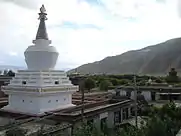
.jpg.webp)
